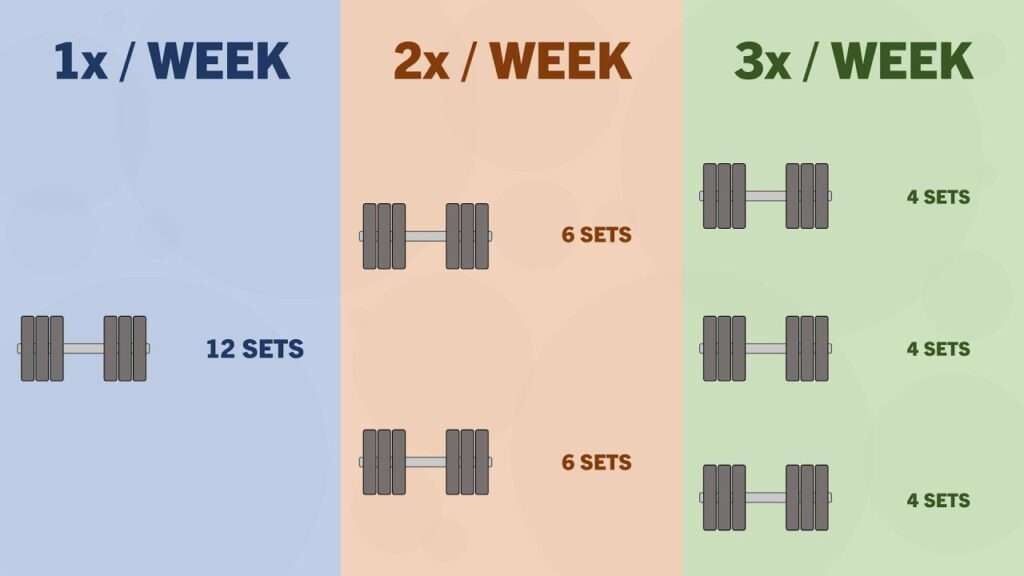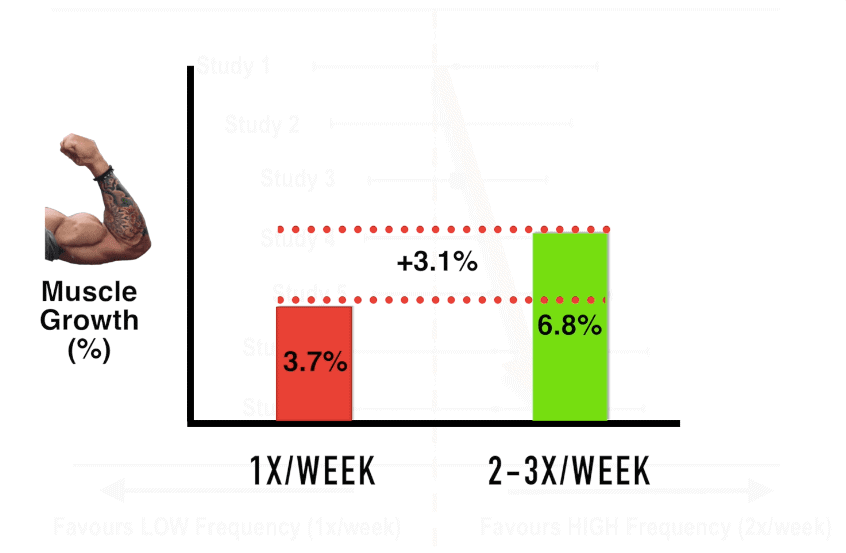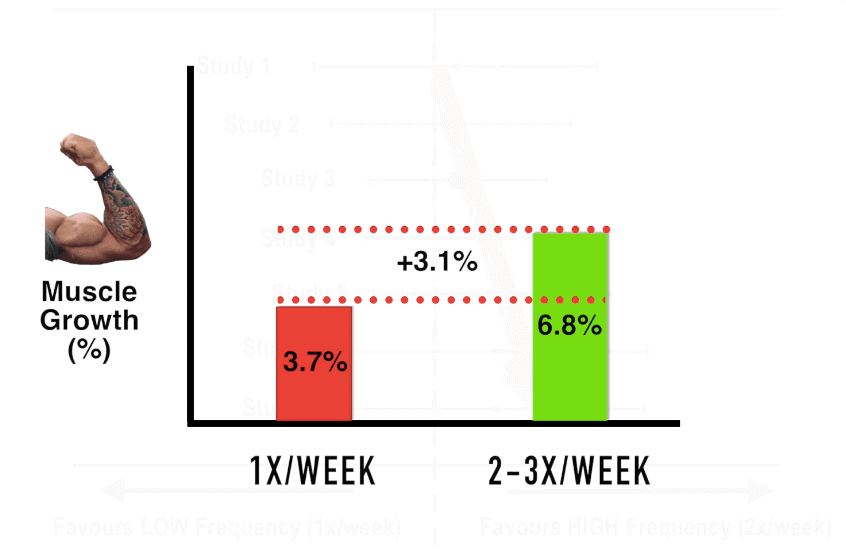So you’ve been hitting the gym regularly, trying to build muscle and get in shape. But have you ever wondered how often you should be training each individual muscle group? It’s a question that has puzzled many fitness enthusiasts, and for good reason. The frequency of training can have a significant impact on your results. In this article, we will explore the optimal training frequency for each muscle group, helping you to maximize your gains and reach your fitness goals.

Chest
Frequency for a beginner
As a beginner, it is important to focus on building a solid foundation for your chest. This means training it with adequate frequency to stimulate growth and development. For beginners, I recommend training your chest at least twice a week. This frequency allows for enough stimulus to promote muscle growth, while also giving your muscles enough time to recover between workouts. A popular split for beginners is a full-body workout performed three times a week, with each workout including chest exercises.
Frequency for an intermediate lifter
Once you have progressed from being a beginner to an intermediate lifter, it is time to step up your chest training frequency. At this stage, your muscles have adapted to the stress placed upon them, and you can handle a higher workload. For intermediate lifters, I recommend training your chest three to four times a week. This increased frequency allows for more targeted stimulation of the chest muscles and promotes further growth. It is important to vary your chest exercises and rep ranges to avoid plateauing and keep challenging your muscles.
Frequency for an advanced lifter
As an advanced lifter, you have likely been training for a considerable amount of time and have developed a solid foundation of muscle mass. To continue making progress and building upon your chest, it is important to adjust your training frequency accordingly. For advanced lifters, I recommend training your chest two to three times a week. While this may seem like a decrease in frequency compared to intermediate lifters, it allows for more intense and focused workouts. Advanced lifters should aim to incorporate a variety of chest exercises, including compound movements like bench presses, as well as isolation exercises to target specific areas of the chest.
Back
Frequency for a beginner
Just like with training the chest, it is important for beginners to focus on building a strong foundation when it comes to training their back. For beginners, I recommend training the back muscles two to three times a week. This frequency provides enough stimulus to promote muscle growth and development, while also allowing for sufficient recovery between workouts. It is important to include a variety of back exercises, such as rows, pull-ups, and lat pulldowns, to ensure all areas of the back are properly targeted.
Frequency for an intermediate lifter
Once you have progressed to an intermediate level, you can increase the frequency of your back training to further challenge your muscles and promote growth. For intermediate lifters, I recommend training the back three to four times a week. This increased frequency allows for more targeted stimulation of the back muscles and helps to build a well-rounded physique. It is important to continue incorporating a variety of back exercises, including both vertical and horizontal pulls, to ensure balanced development.
Frequency for an advanced lifter
As an advanced lifter, you have likely developed a significant amount of muscle mass and strength in your back. To continue progressing and building upon your back, it is important to adjust your training frequency accordingly. For advanced lifters, I recommend training the back two to three times a week. This allows for more intense and focused workouts, as advanced lifters can handle a higher training volume. It is important to continue challenging your muscles by varying the exercises, rep ranges, and intensity techniques used in your workouts.
Shoulders
Frequency for a beginner
When it comes to training the shoulders, beginners should focus on building strength and stability in this muscle group. For beginners, I recommend training the shoulders two times a week. This frequency allows for adequate stimulation of the shoulder muscles, while also providing enough time for recovery. It is important to include both compound exercises, such as overhead presses, and isolation exercises, like lateral raises, to ensure balanced development of the shoulders.
Frequency for an intermediate lifter
As you progress to an intermediate level, it is important to increase the frequency of your shoulder training to continue building size and strength. For intermediate lifters, I recommend training the shoulders three times a week. This increased frequency allows for more targeted stimulation of the shoulder muscles and promotes further growth. It is important to vary your shoulder exercises and rep ranges to avoid plateauing and keep challenging your muscles.
Frequency for an advanced lifter
For advanced lifters, training the shoulders two to three times a week is optimal. At this stage, you have developed a solid foundation of muscle mass and strength in your shoulders, so it is important to focus on maintaining and refining your physique. Advanced lifters should incorporate a combination of compound exercises, such as military presses, and isolation exercises, like rear delt flyes, to target all areas of the shoulders. Additionally, it is beneficial to include techniques like drop sets or supersets to further challenge the muscles.
Arms
Frequency for a beginner
For beginners, it is important to focus on developing both the biceps and triceps to create well-rounded arm muscles. I recommend training your arms two times a week. This frequency allows for adequate stimulation of the arm muscles, while also providing enough time for recovery. It is important to incorporate a variety of exercises, such as bicep curls, tricep dips, and skull crushers, to target all areas of the arms.
Frequency for an intermediate lifter
Once you have progressed to an intermediate level, you can increase the frequency of your arm training to further promote growth and definition. For intermediate lifters, I recommend training the arms three times a week. This increased frequency allows for more targeted stimulation of the arm muscles and helps to develop size and definition. It is important to vary your exercises and rep ranges to continue challenging your muscles and avoid plateauing.
Frequency for an advanced lifter
As an advanced lifter, you have likely developed significant muscle mass and strength in your arms. To continue progressing and refining your arm muscles, I recommend training the arms two to three times a week. This allows for more intense and focused workouts, as advanced lifters can handle a higher training volume. It is important to continue challenging your muscles by incorporating techniques like supersets, drop sets, or even adding more advanced exercises like weighted chin-ups or tricep pushdowns.

Legs
Frequency for a beginner
Leg training is crucial for developing overall strength and power, as well as maintaining a balanced physique. For beginners, I recommend training your legs two times a week. This frequency allows for adequate stimulation of the leg muscles, while also providing enough time for recovery. Leg workouts should include a combination of compound exercises, such as squats and lunges, as well as isolation exercises like leg extensions and hamstring curls.
Frequency for an intermediate lifter
As you progress to an intermediate level, it is important to increase the frequency of your leg training to further challenge your muscles and promote growth. For intermediate lifters, I recommend training the legs three times a week. This increased frequency allows for more targeted stimulation of the leg muscles and helps to improve strength and muscle definition. It is important to vary your leg exercises and rep ranges to continue challenging your muscles and avoid plateauing.
Frequency for an advanced lifter
For advanced lifters, training the legs two to three times a week is optimal. At this stage, you have likely developed a solid foundation of muscle mass and strength in your legs, so it is important to focus on maintaining and refining your physique. Advanced lifters should incorporate a combination of compound exercises, such as deadlifts and squats, and isolation exercises, like calf raises and leg press, to target all areas of the legs. Additionally, incorporating techniques like drop sets or plyometric exercises can further challenge the muscles and promote growth.
Abs
Frequency for a beginner
Developing strong and defined abs requires consistent training and attention. For beginners, I recommend training your abs two to three times a week. This frequency allows for sufficient stimulation of the abdominal muscles, while also ensuring proper recovery between workouts. It is important to incorporate a variety of exercises that target the upper, lower, and oblique abs, such as crunches, planks, and Russian twists, to develop a well-rounded core.
Frequency for an intermediate lifter
As you progress to an intermediate level, you can increase the frequency of your ab training to further challenge your muscles and promote definition. For intermediate lifters, I recommend training the abs three to four times a week. This increased frequency allows for more targeted stimulation of the abdominal muscles and helps to develop a stronger and more defined core. It is crucial to continue varying your ab exercises and rep ranges to prevent plateaus and keep challenging your muscles.
Frequency for an advanced lifter
For advanced lifters, training the abs two to three times a week is sufficient to maintain a strong and defined core. At this stage, you should focus on maintaining your progress and refining your abdominal muscles. Advanced lifters should continue incorporating a variety of exercises that target all areas of the abs, including compound movements like hanging leg raises and cable crunches, along with isolation exercises like side plank twists and seated Russian twists. Additionally, using advanced training techniques such as weighted ab exercises or stability ball workouts can provide an extra challenge for the abs.

Calves
Frequency for a beginner
Training the calves is often neglected, but it is important to develop strong and defined calf muscles for lower body balance and stability. For beginners, I recommend training your calves two times a week. This frequency allows for adequate stimulation of the calf muscles, while also providing enough time for recovery. Calf exercises such as standing calf raises, seated calf raises, and calf press on the leg press machine should be included in your workouts to target all areas of the calves.
Frequency for an intermediate lifter
Once you have progressed to an intermediate level, it is important to increase the frequency of your calf training to further challenge your muscles and promote growth. For intermediate lifters, I recommend training the calves three times a week. This increased frequency allows for more targeted stimulation of the calf muscles and helps to build strong and defined calves. It is important to vary your calf exercises and rep ranges to avoid plateauing and continue challenging your muscles.
Frequency for an advanced lifter
For advanced lifters, training the calves two to three times a week is optimal. At this stage, you have likely developed a solid foundation of muscle mass and strength in your calves, so it is important to focus on maintaining and refining them. Advanced lifters should incorporate a combination of exercises, such as standing calf raises, donkey calf raises, and seated calf raises, to target all areas of the calves. Additionally, it can be beneficial to include techniques like drop sets or single-leg calf raises to further challenge the muscles and promote growth.
Biceps
Frequency for a beginner
Training the biceps is a popular focus for many individuals looking to develop strong and well-defined arms. For beginners, I recommend training the biceps two times a week. This frequency allows for adequate stimulation of the bicep muscles, while also providing enough time for recovery. Including exercises such as dumbbell curls, barbell curls, and hammer curls in your workouts will help target the biceps and promote growth.
Frequency for an intermediate lifter
Once you have progressed to an intermediate level, it is important to increase the frequency of your bicep training to further challenge your muscles and promote growth. For intermediate lifters, I recommend training the biceps three times a week. This increased frequency allows for more targeted stimulation of the bicep muscles and helps to develop size and definition. It is important to vary your bicep exercises and rep ranges to continue challenging your muscles and avoid plateauing.
Frequency for an advanced lifter
As an advanced lifter, you have likely developed significant muscle mass and strength in your biceps. To continue progressing and refining your bicep muscles, I recommend training them two to three times a week. This allows for more intense and focused workouts, as advanced lifters can handle a higher training volume. It is important to continue challenging your muscles by incorporating techniques like supersets, drop sets, or even adding more advanced exercises like weighted chin-ups to your bicep workouts.

Triceps
Frequency for a beginner
Developing strong and well-defined triceps is crucial for overall arm strength and aesthetics. For beginners, I recommend training the triceps two times a week. This frequency allows for adequate stimulation of the tricep muscles, while also providing enough time for recovery. It is important to include exercises such as tricep dips, close-grip bench presses, and tricep pushdowns in your workouts to target the triceps and promote growth.
Frequency for an intermediate lifter
As you progress to an intermediate level, it is important to increase the frequency of your tricep training to further challenge your muscles and promote growth. For intermediate lifters, I recommend training the triceps three times a week. This increased frequency allows for more targeted stimulation of the tricep muscles and helps to develop size and definition. It is important to vary your tricep exercises and rep ranges to continue challenging your muscles and avoid plateauing.
Frequency for an advanced lifter
For advanced lifters, training the triceps two to three times a week is sufficient to maintain strength and definition in this muscle group. At this stage, you have likely developed a solid foundation of muscle mass and strength in your triceps, so it is important to focus on maintaining and refining them. Advanced lifters should incorporate a combination of compound exercises, such as close-grip bench presses and tricep dips, and isolation exercises, like tricep kickbacks and overhead tricep extensions, to target all areas of the triceps. Additionally, incorporating techniques like supersets or drop sets can provide an extra challenge for the triceps.
Hamstrings
Frequency for a beginner
Training the hamstrings is crucial for overall lower body strength and development. For beginners, I recommend training the hamstrings two times a week. This frequency allows for adequate stimulation of the hamstring muscles, while also providing enough time for recovery. Exercises such as Romanian deadlifts, hamstring curls, and glute bridges should be included in your workouts to target the hamstrings and promote growth.
Frequency for an intermediate lifter
Once you have progressed to an intermediate level, it is important to increase the frequency of your hamstring training to further challenge your muscles and promote growth. For intermediate lifters, I recommend training the hamstrings three times a week. This increased frequency allows for more targeted stimulation of the hamstring muscles and helps to develop strength and muscle definition. It is important to vary your hamstring exercises and rep ranges to continue challenging your muscles and avoid plateauing.
Frequency for an advanced lifter
For advanced lifters, training the hamstrings two to three times a week is optimal. At this stage, you have likely developed a solid foundation of muscle mass and strength in your hamstrings, so it is important to focus on maintaining and refining them. Advanced lifters should incorporate a combination of exercises, such as stiff-legged deadlifts, glute-ham raises, and hamstring curls, to target all areas of the hamstrings. Additionally, incorporating techniques like drop sets or adding more advanced exercises like single-leg Romanian deadlifts can provide an extra challenge for the hamstrings and promote growth.
In conclusion, the frequency at which you should train each individual muscle group depends on your training level, goals, and overall recovery ability. Beginners should aim for two to three times a week, intermediate lifters can increase to three to four times a week, and advanced lifters can focus on two to three times a week with more intense and focused workouts. Remember to vary your exercises, rep ranges, and techniques to continue challenging your muscles and avoid plateauing. Training with the appropriate frequency will help you achieve your desired results and maintain a balanced and well-developed physique.

